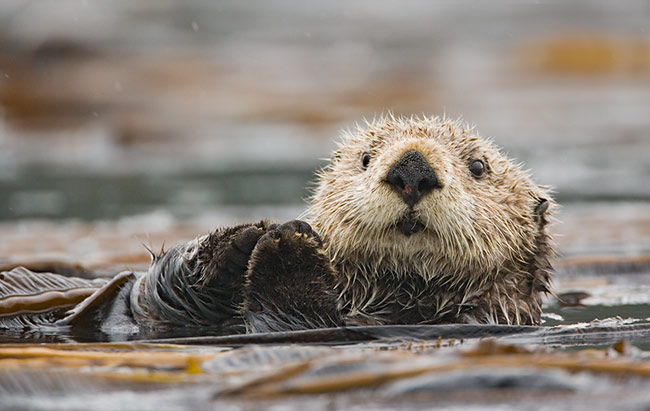
BIRDS
AS ART BIRDS AS ART BULLETIN 207
Visit:
www.birdsasartcom
AIR TRAVEL UPDATE
ROADRUNNER AW
PACKING THE ROADRUNNER AW
BOSQUE 2006 UPDATE
ON THE ROAD
AGAIN AGAIN...
DELKIN e-FILM
PRO COMPACT FLASH CARDS/CRAZY
LOW PRICES
IPT UPDATEs
Contact us
by phone at 863-692-0906 (Eastern Time Zone) or by e-mail at
birdsasart@att.net
or
birdsasart@verizon.net.
The att address is best from overseas.
We gladly accept credit card orders by phone 8am till
You can
use the Paypal links on the web site to order anything. Just type in the item(s)
and the amount. If using your own Paypal account, please send to either of the
e-mail addresses above.

Sea Otter praying,
Image copyright 2006:
Canon 500mm f/4L IS lens with 1.4X II TC and EOS-1Ds Mark II. ISO 500.
Manual Mode: 1/800 sec. at f/5.6 verified by histogram check.
The sea otter kelp bed offered more good opportunities than one could imagine.
The
Photographic
Theme: A few more of my favorite images from my recent Bear Boat trip to
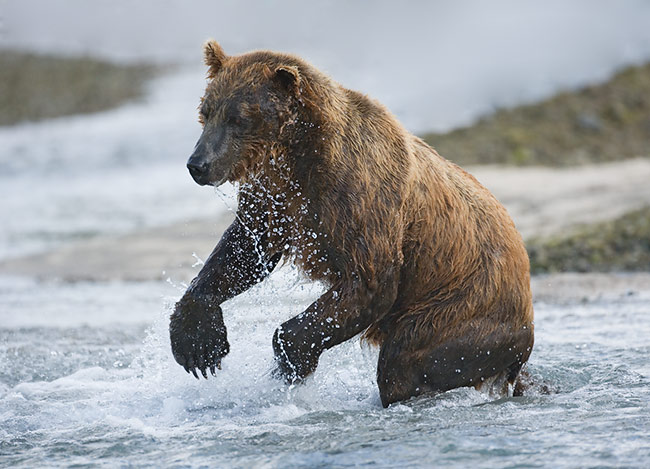
Brown Bear lunging for salmon,
Image copyright 2006: Arthur Morris/BIRDS AS ART
Canon 500mm f/4L IS lens with EOS-1Ds Mark II. ISO
400.
Evaluative Metering:
1/1000 sec.
at f/4.
In order to
totally freeze the water droplets in situations like this choose an ISO and an
aperture that will yield a shutter speed of at least 1/1000 sec. The Sept 4-10,
2008 Bear Boat trip has been planned two years in advance to coincide with the
big surge of chum salmon in Kinak Bay. Those dates in 2005 saw as many as 39
bears fishing the creek mouth at once…
AIR TRAVEL UPDATE
Even if you are
not traveling by air to or through the
AM:
Hi Peggy,
PF:
My husband and I have been anticipating a
vacation to
AM: It’s what is; you gotta
love it…
PF: Now,
no one is allowed to carry on anything when you are flying from
AM: I can understand that but
there are lots of options…
PF: I
just purchased a soft-sided Pelican rolling case and wonder if you think this
would adequately protect my gear.
AM: I am not familiar with
the soft-sided Pelican rolling cases… I would not put any photo equipment in a
soft-sided case that is to be checked.
PF: I
have a Canon digital 20D, 28-135 IS lens and also the 70-200 IS 2.8 lens and
would be terribly upset if my gear was damaged.
AM: Aside from the
possibility of having your stuff damaged, there is a great and real danger of
theft. It is much easier to safely pack photography gear that is to be in your
checked baggage than it is to guarantee that it will be there when you arrive at
your destination…
PF: Do you have a suggestion?
AM:
There are many complex issues to be considered. Here are some of my thoughts:
Folks traveling
to the
If I were flying
to the
If you choose to
put your equipment in your checked baggage, your first consideration needs to be
whether your luggage will have a combination lock or if it can be locked with
the TSA locks (and I am not sure if they will be OK for use on flights to and
from the
If you have or
choose bags with combination locks, you may or may not be able to lock your
bags… When I fly from
In many
airports, however, the TSA inspection areas are behind the scenes; you give your
bag to the agent at check-in. I have been told that if you give the combination
for your bags to the ticket agent and request that they enter the numbers by
with your ticket information on computer, that the TSA will call the airline
before breaking the lock… I have never been brave enough to try that because I
fear that they would simply break the lock and then ship the bag with the likely
outcome that all of the contents would fall out of the bag… I have tried placing
a note my bags requesting that the TSA agent spin the combination lock after the
bag is inspected but they have always ignored the note and failed to lock the
bag…
If you opt for a
bag that can be locked with a standard lock, you have the option of purchasing
the special TSA locks. I have never used them. You lock your bags with the TSA
locks. The TSA has the combination for all of these locks. Thus, your bag is
supposed to be safe… Do realize that any time that you put a camera or lens in
a checked bag that either the bag or the equipment may be stolen.
Once you have
decided on the type of lock on your bag, you need to decide whether you will go
with hard-sided cases or soft sided cases. If you will be placing a camera or
lens in a checked bag I would recommend only hard-sided cases. I routinely send
my Gitzo 1325 Carbon Fiber tripod (http://www.birdsasart.com/accs.html#GITZO%201325%20CF%20TRIPODS)
and my Wimberley V-2 head (http://www.birdsasart.com/accs.html#WIMBERLY)
in my checked bags as it is impossible to carry those on along with my
Roadrunner AW and my computer bag. At times I have used a large rolling duffle
(as a checked bag) for the tripod provided you used a hard-sided bag as your
second checked bag and placed any cameras or lenses in the hard-sided case.
I use Delsey
29" hard-sided cases and love them. They have been all over the world several
times. On two occasions, baggage handlers managed to rip out one of the locking
clasps on the side of the case, but the lock on the front of the case and the
lock on the other side of the bag have always held. Unfortunately I am pretty
sure that the type of Delsey bag that I use is no longer available… A friend
purchased a hard-sided Delsey bag a few years ago on my recommendation. It was
similar to the new Delsey Meridian Plus bags. The bag turned out to be junk;
the lock broke on her first trip and the case was pretty much unusable.
Once you have
your bag, you need to pack your gear safely. As far as I am concerned, the best
way to protect gear is with clothing, lots of clothing. I normally travel with
a heavy bathrobe; it is ideal for wrapping around an intermediate telephoto lens
or a valuable camera body (if placing the item in a checked bag is your only
option). Coats and heavy sweatshirts also work well as packing material. I
often use my hiking boots and or my tripod to form a sort of protective barrier
around a lens or camera body. I always place a lens or a camera in the bag
close to the handle so that the weight of other item in the bag do not press
down on it when it is handled by the handle. You should
never
travel anywhere with a camera body attached to a lens as damage to or
destruction of your gear is likely no matter how well it is packed.
For now, it is
still OK to fly to most locations with one legal carry-on and one computer bag
(but those days may be coming to an end…) I still rely on my Roadrunner AW to
protect the lenses and cameras that I carry aboard. To learn more about the
Roadrunner AW, click here:
http://www.birdsasart.com/bn84.htm Note: we are expecting our first
shipment of Roadrunner AWs on Friday, August 18. To learn how I travel with all
my gear at present click here:
http://www.birdsasart.com/bn150.htm.
Important note: After 9-11 lots of folks felt that it was impossible to travel
with photo gear. I felt (and wrote) that things were really not very much
different at all after 9-11 than before. Do realize that traveling by air today
with photographic gear (with non-UK itineraries) is pretty much the same as it
was before the recent terrorist threats (but for the fact that we cannot carry
on anything to drink and the fact that we will have to get to the airport an
hour earlier). So while
traveling with our photographic gear by plane
has become a bit more difficult,
there are safe and
practical solutions
provided that you give the problem some
thought and make wise choices.
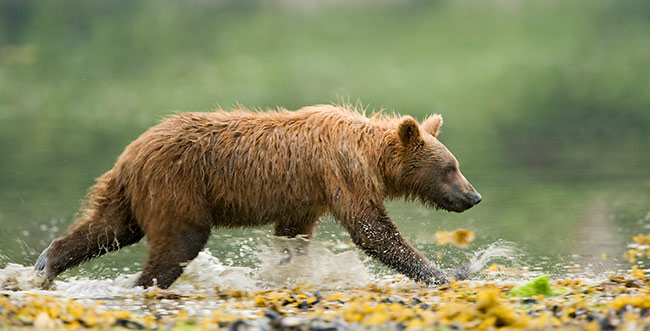
Brown Bear yearling cub running,
Image copyright 2006:
Canon 500mm f/4L IS lens with 1.4X II TC and EOS-1Ds Mark II. ISO
400.
Evaluative Metering:
1/160 sec. at
f/5.6.
Once I saw this
bears sibling amble off with momma, I hurried to get down on the ground knowing
that he would soon be re-joining his family. Just as I got on the ground, I was
rewarded when he st
ROADRUNNER AW
For many years, I have been
extolling the virtues of the Lowepro Roadrunner AW, the world’s largest legal
carry-on. In all of my extensive travels I have never once been told that the
bag was oversized when I was traveling on a full-sized jet. As is usually the
case, many folks have been listening to what I have been saying.
On most nearly everyone traveling by air is using this great bag
because it allows you to maximize the amount of gear that you carry on while at
the same time fully protecting your valuable photographic equipment. You can
learn more about the Roadrunner
AW by clicking here:
http://www.birdsasart.com/bn84.htm.
In an effort to
offer you a more complete one stop shopping experience we have added the Lowepro
Roadrunner AW to our BAA Mail Order line-up:
Lowepro Roadrunner AW: $449.98 plus $20 shipping by UPS ground. Signature
required. US only.
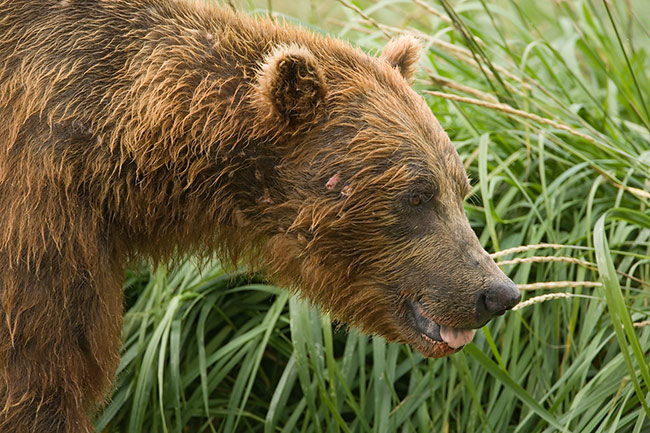
Brown Bear “Scar,” Geographic Harbor,
Image copyright 2006:
Canon 500mm f/4L IS lens 1.4X II TC and EOS-1Ds Mark II. ISO
400.
Manual Mode: 1/500 sec. at f/5.6 verified by histogram check.
This was
“Scar’s” good side. He looked as if a huge bear had bitten him as he had a
large wound on the other side of his head in the same spot. After a few minutes
you are completely comfortable being around the Katmai bears. Scar was the best
fisherman in Geographic.
.
PACKING THE
ROADRUNNER AW
For as long as I can remember,
folks have been asking to see photos depicting exactly how I pack my Roadrunner
AW. Well, I have finally gotten around to it. Here goes:
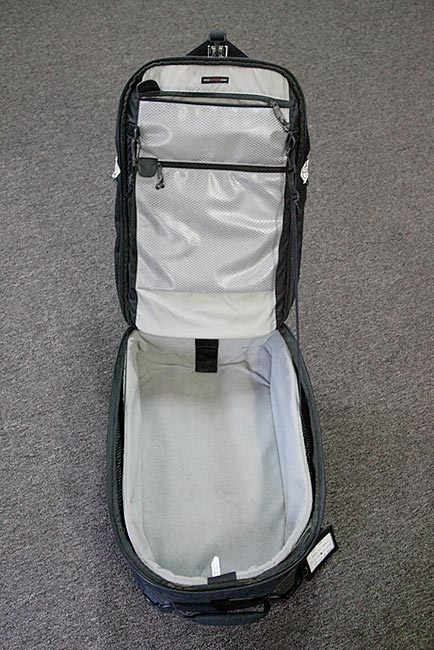
This is the
empty Roadrunner with all of the harnesses removed and all of the straps cut
off.
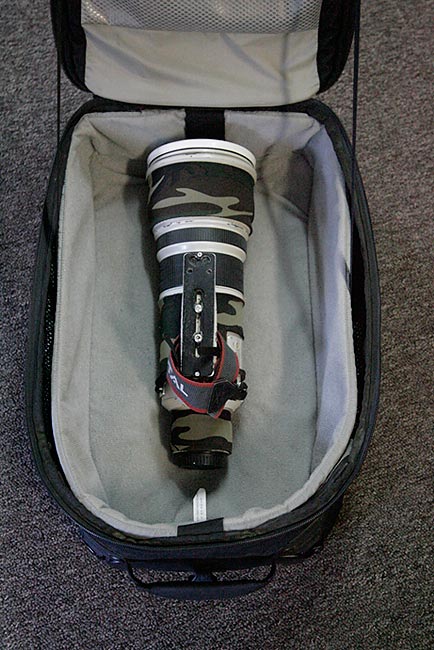
First I remove
the hood (which will go in a checked bag) and then place the 99 cent Corning
Ware plastic cover over the front of the lens.
Then I wrap the
lens strap around the foot and place the 500mm f/4L IS lens in the case as show.
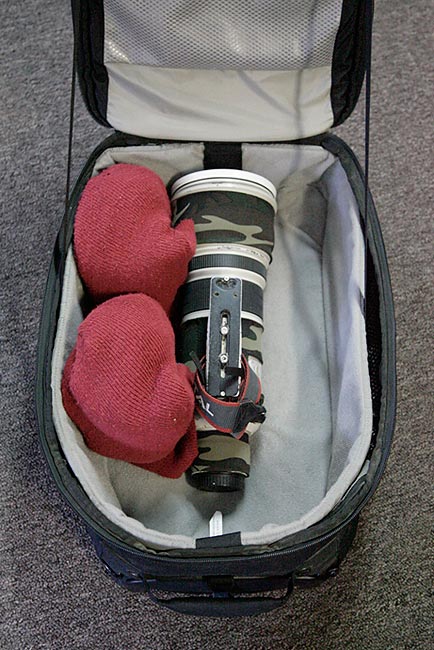
Then I place
each of my camera bodies (an EOS-1Ds Mark II and an EOS 1D Mark II N) in double
watch caps for protection and place them in the case as shown.
I find it
easiest to place the bottom of the cameras on the bottom of the bag.
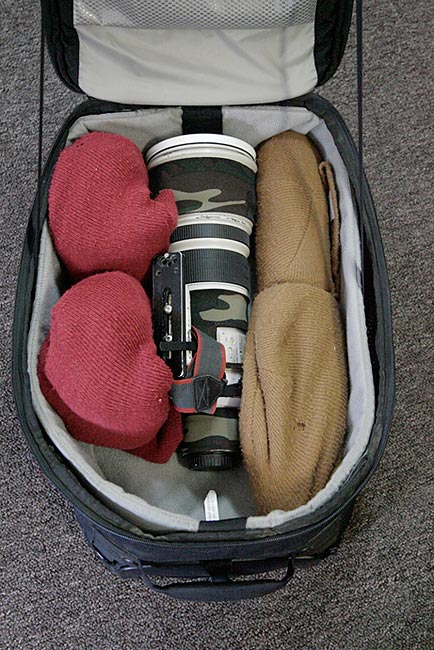
Next I place two
intermediate telephoto lenses in their own watch caps and place them in the case
as shown.
In this image the 70-200 f/2.8L IS lens is on the upper right and the 400mm
f/5.6L lens is on the lower right.
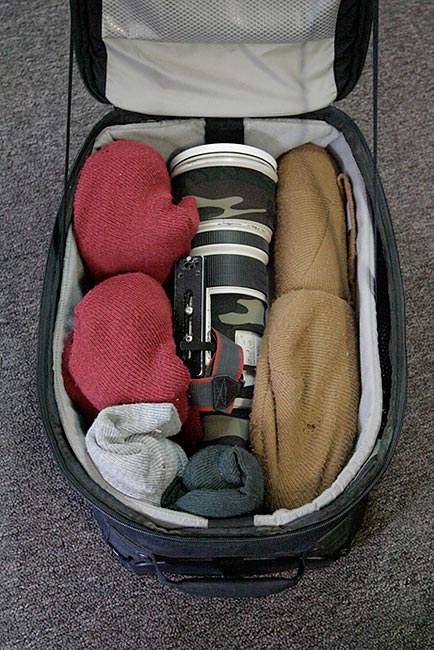
Next I place the
24-105 IS L zoom lens (front element down) in the lower left hand corner of the
case (in its own light grey watch cap) as shown.
Then a set of
stacked teleconverters (a 1.4X II and a 2X II) is placed in the empty spot at
near the end of the 500 IS.
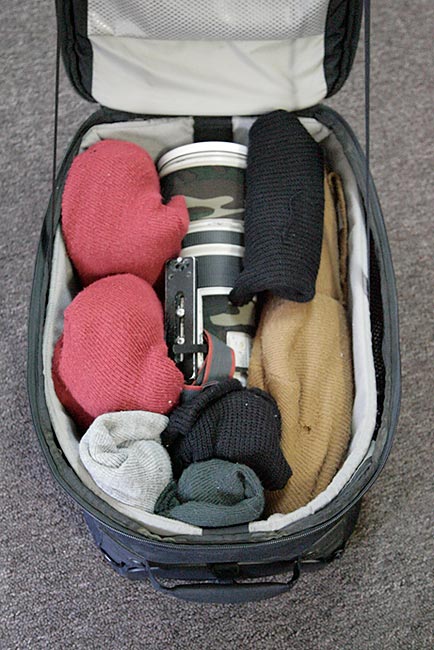
The 1.4X TC that
I use with my 70-220 (lower center in a black watch cap) is placed atop the
near-end of the lens barrel
while my 580
flash, also in its own black watch cap is laid in the slot atop the 70-200 lens.
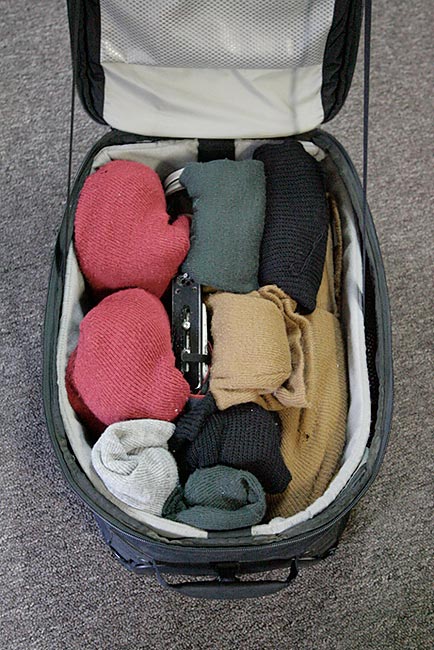
A set of three
extension tubes (two 25mm and one 12mm tube stacked, in the brown watch cap) is
put into place
next to the lens
foot and plate that has been shifted to the left as shown. Lastly, an extra
battery (in the green cap, upper center) is placed in the case as shown.
The image above shows exactly
how I pack my Roadrunner AW for a typical
trip. (On different trips I will often take a different combination of
intermediate telephoto lenses.) On most trips I pack my Gitzo CF 1325
tripod, my V-2 Wimberley head, and an extra camera battery or two in my checked
bags and also include
an extra set of stacked teleconverters. The Roadrunner AW as shown above
weighed just a shade under 40 pounds (which is the legal limit for carry-ons in
the
To order
a Roadrunner AW, see the
information in the previous item.
BOSQUE UPDATE
It's a fact. As determined by
refuge biologists, the crane pools west of Highway 1 will be kept dry this
winter to ensure to protect the
alkali plant
communities. This will help visiting photographers by forcing them
to look for new and different opportunities and to expand their creative
vision. You can read the entire
text of John Vradenburg’s explanatory
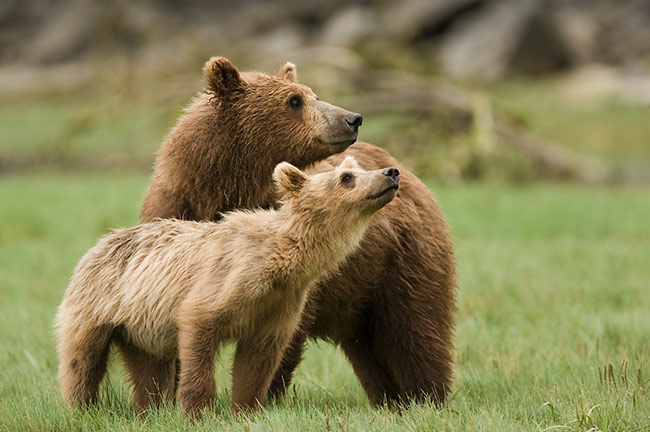
Brown Bear, blonde yearling cub with momma,
Image copyright 2006:
Canon 500mm f/4L IS lens with 1.4X II TC and EOS-1Ds Mark II. ISO 800.
Evaluative Metering +1/3 stop: 1/640
sec. at f/5.6.
When you are photographing two birds or two animals, you need to be alert for pleasing juxtapositions, head angles, and body angles. If you think, “mother bear with baby,” and push the shutter button only out of excitement, your buffer may be full when the perfect pose (see image above) is there…
ON THE ROAD AGAIN
AGAIN...
I fly to Dulles on Sunday to
visit younger daughter Alissa,
her husband Azik, and my second grandson, Ilyas. On Monday I fly to
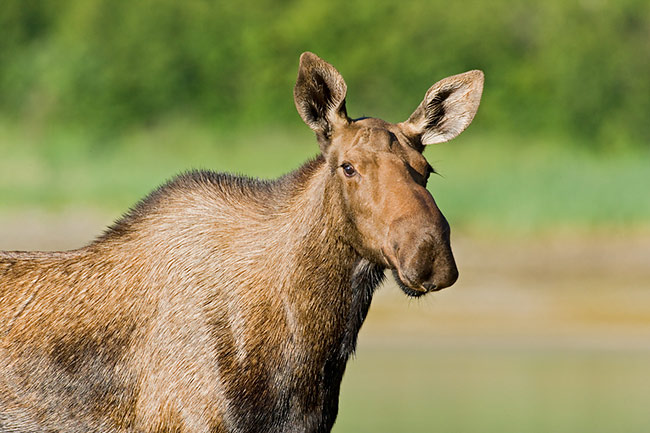
Moose, adult female,
Image copyright 2006:
Canon 500mm f/4L IS lens with 2X II TC and EOS-1Ds Mark II. ISO 400.
Evaluative Metering: 1/320 sec. at f/11.
We
were all amazed when this Moose walked right up to us. I like the soft
background in this image.
Note: It ain’t just birds! See
Lots of out of town folks from
California, Colorado, Texas, Maryland, Toronto, and even two from Norway have
already signed up for the weekend. The
We are now accepting
registrations. Paypal is best but we will be glad to take your credit card
information by phone (863-692-0906) or to cash your check. If sending a check,
please make it out to “Arthur Morris” and send it to us at BIRDS AS ART,
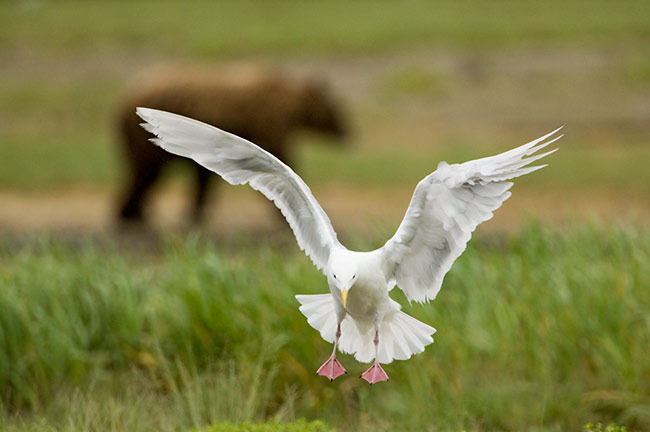
Glaucous-winged Gull and Brown Bear,
Image copyright 2006:
Canon 500mm f/4L IS lens with 2X II TC and EOS-1Ds Mark II. ISO 500.
Evaluative Metering -2/3 stop: 1/1250 sec. at f/8.
I
was tracking the gull in flight when I saw the bear in the background so I
pushed the button <smile>
DELKIN e-FILM PRO
COMPACT FLASH CARDS/CRAZY
LOW PRICES
As
most of you know, I have used Delkin e-Film Pro Compact Flash Cards for more
than 3 ½ years now and have found them to be fast and dependable. I have been
using the Delkin 2gb and 4gb cards exclusively now for more than two years and
have experienced one card failure, that with a very old 2gb card about a month
ago. Delkin promptly replaced the card. Do remember that I take tens of
thousands of images in a given year. We have joined with Delkin to ensure that
we can offer you the great e-Film Pro Cards at very low prices in any quantity
that you might need:
1gb Delkin e-film Pro Card:
$44.98
2gb Delkin e-film Pro Card:
$74.98
4gb Delkin e-film Pro Card:
$154.98
8gb Delkin e-film Pro Card:
$299.98
Please add $7.00 per order
shipping and handling.
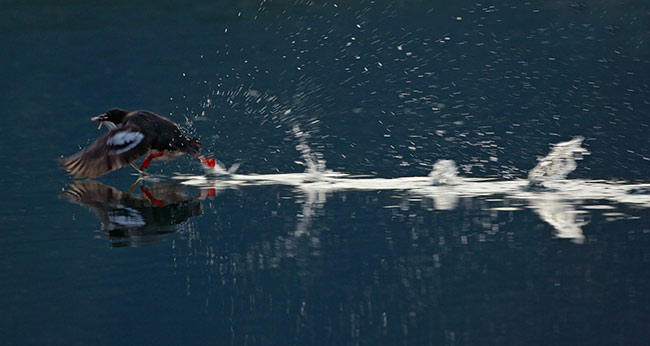
Pigeon Guillemot taking flight with large fish, Geographic
Image copyright 2006:
Canon 500mm f/4L IS lens with EOS-1Ds Mark II. ISO 400.
Evaluative Metering -1 stop: 1/250 sec. at f/5.6.
We
photographed this species from both the skiff and the big boat. For the most p
.
IPT UPDATES
It is quite gratifying for me to note that all four Bosque IPTs are sold out so
far in advance. <big smile> We urge interested folks to have their names placed
on the waiting list for sold out IPTs as cancellations are virtually a
certainty.
Bosque #1: "The
Fall Color IPT"
Bosque #2: "The
Pre-Thanksgiving IPT"
Bosque #3: "The
Post-Thanksgiving IPT"
Bosque #4: "The
Full Moon IPT" DEC 4 (mid-day) through DEC 7 (mid day), 2006. 3-DAY: $929.
(SOLD OUT)
Slide Program mid-day on DEC 4.
Co-leaders include Manuel Presti, 2005 Wildlife Photographer of the Year, and
Robert Amoruso. This IPT includes a half day of
photography on the 4th, two full days of photography on the 5th and 6th, and a
final half day on December 7th. Limit 14. This IPT has been scheduled to
maximize the opportunities to include the rising and setting full (DEC 5) and
near-full moon in your images. There will be lots of the usual chances as well,
and this time period has provided more than its share of spectacular sunrises
and sunsets over the years.
San Diego
IPT:
Fort DeSoto
IPT: APR 13-15, 2007. Slide program on the evening of Thursday, APR 12. 3-DAY:
$999 (Limit 14:
(SOLD OUT) Co-leaders:
Robert O’Toole,
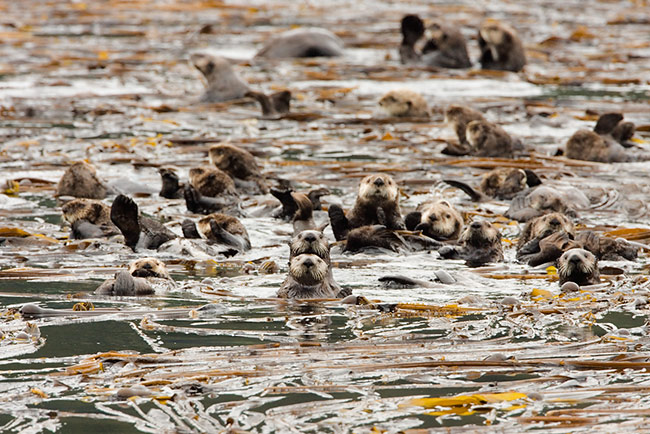
Sea Otters in kelp, Kodiak, AK
Image copyright 2006:
Canon 500mm f/4L IS lens with 1.4XII TC and EOS-1Ds Mark II. ISO 500.
Manual Mode: 1/200 sec. at f/10 verified by histogram check
I
made this image while photographing from the deck of the big boat. I wanted to
show both the animals and the patterns in the kelp.
Best and love and great picture-making to all,
artie
Note:
Arthur Morris has been a Canon contract photographer since 1994 and continues in
that role today. Hunt's Photo of Boston, MA is a BAA sponsor as it Delkin
Devices. Back issues of all BAA Bulletins can be found in the Bulletin Archives
which may be accessed from the home page at
www.birdsasart.com